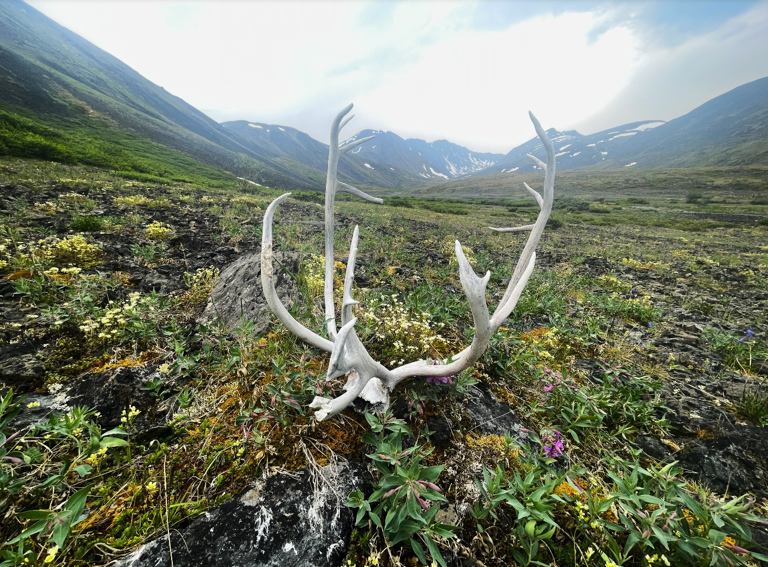
An Agiak adventure to remember
By Teresa Clemmer
To celebrate our 50th Anniversary, a cohort of Trustees for Alaska staff and supporters recently traveled to Agiak Lake within the Gates of the Arctic National Park. Where exactly is Agiak Lake, you ask? Well, it may seem like it’s in the back of beyond, tucked in a valley on the north side of the Brooks Range, but it’s actually smack in the center of everything we care about in the Arctic.
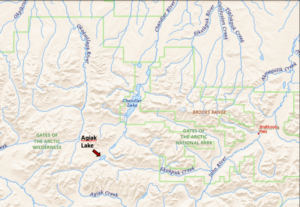
Map of north-central Brooks Range (Source: BLM LMAR Interactive Map, edited by Teresa Clemmer)
Fun fact: Agiak Lake sits right at the Continental Divide! On one side of our base camp, water was flowing north toward the Arctic Ocean via the Chandler River. Our camp was in a nature-made wind tunnel that brought us steady Arctic Ocean breezes and largely kept the mosquitoes at bay. Woo-hoo! I could completely understand why caribou migrate thousands of miles to feed and raise their young in these breezy coastal areas, lush with a rainbow of yummy lichens, moss, and flowers. With caribou antlers, skulls, bones, and fur just about everywhere we looked, there was no doubt we were in the midst of prime caribou habitat. One night, as we were heading into our tents to sleep, we were treated to the sight of a lovely caribou—with her glossy brown fur and fluffy white butt—casually wandering up the valley past our campsite in the shimmering evening light. It doesn’t get much better than that.
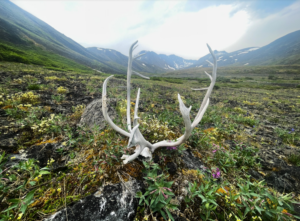
Caribou antlers in a creek valley east of Agiak Lake (Photo: Teresa Clemmer)
The Chandler River feeds into the incredible Colville River and its marshy delta, which support a wide array of migratory birds, including red-throated loons, Arctic terns, brant geese, king and spectacled eiders, and many others. Our bird-nerdy crew had a blast identifying many of them! It was awe-inspiring to know we were just across the plains from important winter habitat for denning polar bears and ice seals too. We kept our bear-spray close at hand, in case we might have a too-close encounter with a brown bear. Their scat and feeding sites were certainly visible on our hikes.
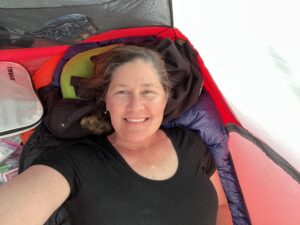
Contemplating the wonders of the Arctic in my tent (Photo: Teresa Clemmer)
Trustees attorneys and our clients and partners have put in long hours working to protect these Arctic species, so spending a little time in their home turf meant a lot to me. Lying in my tent, I had a lot of unplugged time to soak up the special places all around us and ponder those a little farther afield too, including the Coastal Plain of the Arctic Refuge to the east, and Teshekpuk Lake, Peard Bay, Kasegaluk Lagoon, and the Utukok River Uplands to the west.
What about the other side of the Continental Divide, you ask? Water from Agiak Lake was flowing southward into Agiak Creek and then into the John and Koyukuk rivers. What a feeling to be connected to the Koyukuk! This is a watershed that means everything to the Koyukon people who have been thriving alongside its meandering waterways for millennia. Trustees has spilled a lot of ink discussing the harmful impacts the Ambler Road would have on these communities and the salmon, sheefish, and caribou they depend on. On the way to and from our base camp, it was breathtaking flying over and seeing for myself the North Fork of the Koyukuk flowing through the Gates (Frigid Crags and Boreal Mountain). It was also a huge relief to think of the U.S. Bureau of Land Management’s recent decision echoing our advocacy and denying approval for a reckless project that would devastate the Koyukuk and many other watersheds in the region.
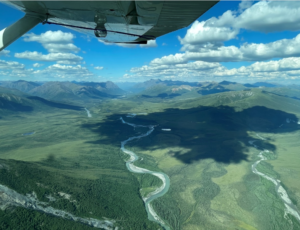
Aerial view of the “Gates” and the North Fork of the Koyukuk River (Photo: Teresa Clemmer)
Throughout the trip, we took full advantage of our prime location at Agiak Lake. Each day, we explored the rolling foothills and side valleys all around us, with their alpine lakes, meadows thick with colorful flowers, crystal clear creeks, huge patches of aufeis (accumulated layers of sheet ice), and archaeological reminders of the nomadic Indigenous people who hunted in this area for thousands of years, including tent circles and inuksuks (piled or standing stones arranged in lines to guide herds of caribou).
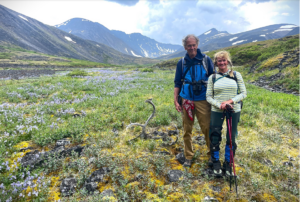
Richard Hughes and Jo Ann Burtard in a field of Jacob’s ladder and other wildflowers, moss, and lichen (Photo: Teresa Clemmer)
By far the best part of the whole adventure was having the chance to spend a week with a truly fantastic collection of people. While our guides gave us the royal treatment—with amazingly delicious food and a super-well-organized camp—we chatted, laughed, traded stories, and took a much-needed break from civilization. It’s an experience I’ll never forget.

Relaxing at camp with Carl Johnson, Leonard Steinberg, Cindy Hendel, Brooke Edwards, and Haley Johnston (Photo: Teresa Clemmer)


